**This game was also published on fifthgengaming.blog and can be found here**
Why am I doing this?
Like everyone, there are games I don't enjoy, there are genres that don't appeal to me, and developers whose games I can't stand. This usually doesn't matter too much. I've never enjoyed a single Naughty Game I've played, but there are plenty of other things I can do with my time. I've never jibed with the dungeon design in the Zelda series, but games use a variety of styles for level design. It's normal to dislike some things and like others, everyone has their own idiosyncratic preferences. But then there's FromSoftware.
When Demon's Souls came out, it was easy to write it off as a game for weirdo freaks without begrudging them their niche. Dark Souls was released two years later to universal acclaim, with assurances that it was a much more playable game than its predecessor. That media environment rope-a-doped a young and easily influenced version of me into buying a copy out of FOMO. It turned out it was still a game for weird freaks and video game reviewers had all caught some kind of memetic virus. Even though I was out $60 on unplayable ragebait, I came away knowing which media voices were untrustworthy and the consolation that FromSoft's particular nonsense was unique, and no other studio would replicate it. The weird freaks would over time get the Dark Souls sequels they deserved, and there's nothing wrong with that. Four years later, the world would be burdened with the existence of Bloodborne. There was a similar reaction to it by the game press, but as I was by now once bitten, twice shy, I waited until the accursed thing was on deep discount before trying it out. It was the same result, but that time I was only out $20 for the knowledge.
[REDACTED: Picture of me doing the Youtuber thumbnail face and pointing at Elden Ring box art]
I didn't fall for Sekiro, as the public FOMO pressures were subdued for that one. Then there's Elden Ring. There was the universal acclaim we all have come to expect, but it seemed like everyone who owned a current gen console bought the thing and the word-of-mouth pressures were ratcheted to the highest level possible. Suffice to say it was a Charlie Brown trying to kick the football kind of situation. Looking at this story on its own, you could conclude that I'm just a schmuck who needs to git gud. But here's the rub, these pieces of crap make so much money and have such social media exposure that the tide of copycats has been rising steadily since 2011. It's to the point that Action RPGs have almost completely been subsumed into the "Soulslike" sub-genre. That is the true problem.
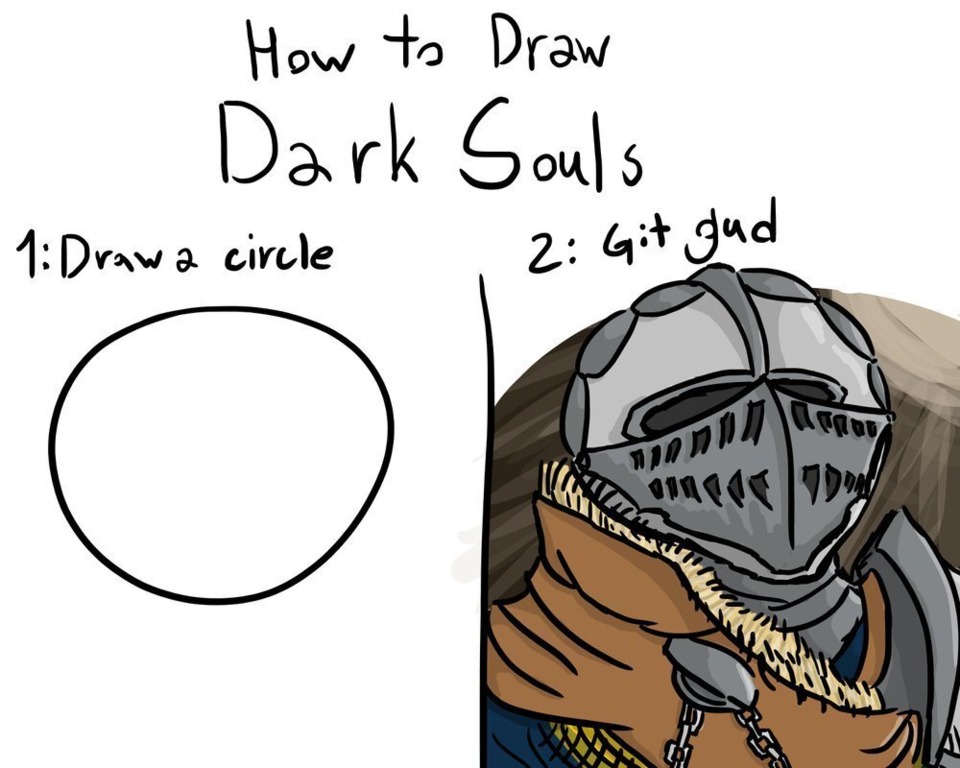
I would love nothing more than to rip the various genre conventions of "Soulslikes" which originated as copycats to FromSoft's Soulsborne games to shreds and incinerate the pieces. Yet, I don't want to fight a last stand against the internet without being sufficiently armed. I'm not going to feel prepared without a full understanding of the background behind the development of Soulsborne game design. That requires research, and the first step in that research is to look at the origins of the developer. Where did the studio come from? What is the source of their design philosophy? How did things come to this? The thread of any aspect of history can be followed all the way back into irrelevance, so I'll confine my initial effort to the works of FromSoft. All of this means that I will endeavor to play every one of their games in the order that they were released. I'll keep an eye on design traditions and how they change or stagnate over time. Most of the people who undertake this kind of thing have already fully drunk the modern Soulsborne Kool-Aid, and I've never seen satisfactory analysis from those sources. I will approach this topic with a more critical eye than it is accustomed.
First things first. FromSoftware existed for a while before, unfortunately, getting into game development. We will need to start there before we get to the virtual masochism.
----------------------------------------------------------------------------------------------------
History
From what I could tell, a man named Naotoshi Zin got into a motorcycle crash somewhere in Tokyo in 1984 or 1986. He apparently received a large cash payout from his insurance provider and spent his medical recuperation putting together a business idea. The fog of time and the language barrier prevents us from knowing more details than that, but he eventually registered a new business on November 10, 1986, under the name FromSoftware, inc. If anyone knows why the company was founded under that name, they haven't recorded it in English. Zin's company would spend the next several years producing business software. I've seen references to agricultural management and accounting software that I have not been able to confirm.
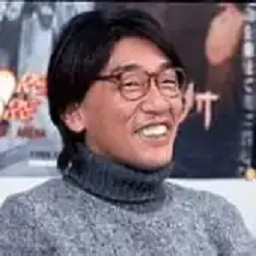
Regardless of what actually happened in the 80's, by the early 90's Zin was looking to diversify FromSoft's products. Supposedly, the idea to move into video games came from one of the company's software developers, Yasuyoshi Karasawa, who had been messing around with early polygonal rendering programs. Zin was a big Wizardry fan because of course he was and set aside a small team of three or so guys to prototype out some ideas for a PC-98 game. That project fell through, but with the announcement of the Sony Playstation, Zin and his enthusiastic game team decided to roll the dice with that upcoming console. They had apparently spent a lot of time going back and forth on whether to create a mecha or fantasy dungeon crawler, with fantasy winning out fairly late in production. As the story goes, King's Field began serious development in March 1994 and was showcased two months later under the name Crystal Dragon at what was probably the Tokyo Toy Show, which was a predecessor to the Tokyo Game Show.
I don't know how much to trust the few details I have about this time period, so I'm keeping this narrative at a high level. The game was a complete mess for most of its development, with maybe 10 people on the production team who had never made a game before. Yet, the fact that they were trying to make a fully polygonal dungeon crawler was weird enough to catch a little bit of Sony's attention and get them a license to publish on the upcoming console. Sony also seems to have sold some necessary 3D rendering equipment to Zin for 2 million yen during the game's development. Even then it can't be overstated how little the guys at FromSoft knew about what they were doing, and Eiichi Hasegawa was hired as lead programmer partway through development specifically because he had worked on games before. Hasegawa likely had a large hand in making the thing playable at all in time for the PS1 launch.
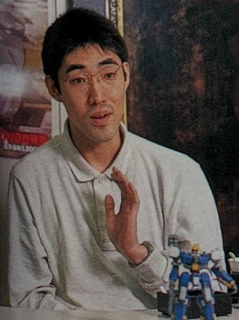
Even then, the combination of the team's outdated tastes in games, ignorance of design best practices, and a ton of corner-cutting led to the end product being a weird, janky, and barely playable game. King's Field released in Japan on December 16, 1994, exclusively for the PS1. It had no marketing budget, and since FromSoft needed Sony's assistance to physically publish the game, only around 13,000 copies were initially printed. The game bombed with Japanese reviewers and wasn't expected to receive any player interest. It didn't at first, for reasons we will discuss shortly, but it gradually garnered a cult following on early internet message boards. Its popularity gradually increased in the months after release, and it sold somewhere around 200,000 copies by the middle of 1995. This was encouraging enough that Zin and co. immediately began work on a sequel, but that's a story for the future because first we need to grapple with the reality of what King's Field even is or is trying to be.
----------------------------------------------------------------------------------------------------
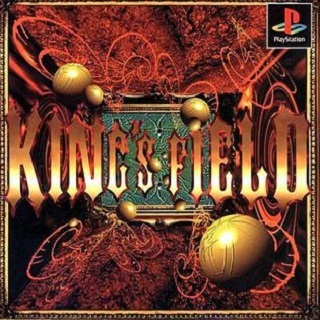
King's Field
Release Date: 12/16/1994
Project Head: Naotoshi Zin
Lead Programmer: Eiichi Hasegawa
Original Prototype: Yasuyoshi Karasawa
Development Staff: Noriaki Yoshikawa, Toshio Shimada, Nobuo Takemasa, Toshiya Kimura, Miyuki Wake, Shinichi Komai, Masashi Moriya, Junji Izaki, Yuko Takahashi, Yoshiki Hirota, Hiroyuki Arai, Shinichiro Nishida, Taku Ichinose, Mitsushiro Okamura, Sakumi Watanabe
Sound Design: Yasushi Kawakami
Composers: Koji Endo, Kaoru Kono
Time to Completion: 8 Hours 33 Minutes
The game which made its way onto store shelves is a fantasy first-person Dungeon Crawler with free movement. That's a lot of descriptors, so let's start with what that means. Hopefully anyone reading this knows what a Dungeon Crawler is; the old genre was popularized by the Wizardry series and most computer RPGs from the 80's were in this style. The basic idea is to take the spelunking parts of a typical D&D campaign and use the computer as a dungeon master. I spent most of my post on Hydlide talking about the history of RPGs, so read that for context. The first-person viewpoint was a common angle for Dungeon Crawlers, so that's very normal, and when I say fantasy, I mean there's magic and dragons. The interesting part is the whole free-movement thing. What I mean by that is the player can move around however they want, not aligned to any kind of grid or preset viewpoints. This technical innovation was popularized by 1992's Ultima Underworld, which was also notable as being the immediate inspiration for Wolfenstein 3D. Once developers all over the world realized this technique had become feasible, everyone started iterating on it. I've gone into all these minutiae because this specific kind of game had not been executed particularly well on consoles up to this point, and it still wouldn't be for some time, if I'm being honest. For some context, King's Field came out the same month as AD&D Slayer on the 3DO.
Now that we've defined the thing, what actually happens in King's Field? A translated scan of the game manual lays out a very straightforward premise: there's an ancient underground temple turned cemetery which the king of this fantasy kingdom has had guys digging around in looking for magic stuff. One day, monsters appeared in that cemetery and the king keeps sending guys in to clear it out. You play as some dude named John whose father led some soldiers into the dungeon and didn't return, so of course you go in after him. The game starts much like Ultima Underworld with your character standing right inside of the front doors. Like that game, there are a few friendly NPCs to talk to on the first level and a lot of nonsense beneath. Those NPCs on the first level include the groundskeeper, a priest overseeing the cemetery chapel, the lone remaining garrison soldier, a legitimate shopkeeper who I guess services the soldiers, some grave robbers, and an illegitimate shopkeeper who likes ripping you off. There's also a lot of dead soldiers lying around because things haven't exactly gone well. These literally faceless idiots will give small tidbits of lore as you wander deeper into the dungeon, but it all amounts to very little. The first level is also the only place with shops and a healing fountain, so you'll be going back and forth to the starting area pretty often, as was the fashion of early cRPGs.
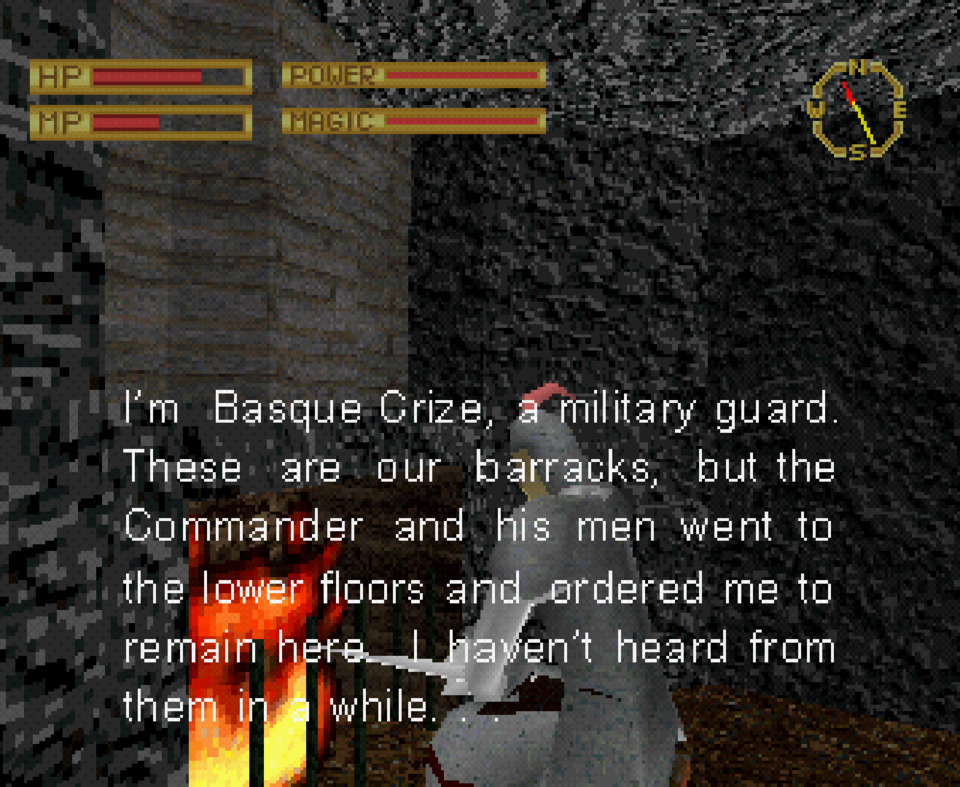
Those NPCs are kinda necessary for getting past that first floor. There are a couple of simple item fetch quests you need to do before the game fully gets into gear. One of the guys mentions how the garrison scribe ran off with a shiny chalice for whatever reason, and you can find that guy's corpse in a side tunnel with the big cup and a message scrawled in the wall saying to put the thing back where it came from. Through trial and error, you can slot it into an alcove that activates the one healing fountain in the game, which was previously turned off. Then there's the map, which is not immediately available. You meet a graverobber in a random tunnel who tells you that his son went off somewhere with their map. You can eventually stumble across the son's corpse in a hidden room and acquire that map. Finally, in order to get to the second floor of the dungeon, you need to turn off an arrow trap, and to access the controls you need to get the key that opens most of the locked doors in the game on the first floor. The priest has it, though there's no way for you to know that. What you can learn is that someone stole the priest's cross, and he wants it back. When you eventually come across the second shopkeeper, who's located too far into the level to expect any business, he'll sell the cross to you for way too much gold. You have to thoroughly scrounge every accessible area of the floor for all the loot in order to afford that cross. From there you can exchange the cross for the key, which you don't know the priest has, and move on with life. All this stuff on the first floor took me like two and a half hours to do, and the level isn't that big.
There are a few very good reasons for that. First, the movement speed is glacial. Second, the combat takes a while at the beginning of the game. The thing with old school dungeon crawlers is that they have inverted difficulty curves with a spike at the end for the final boss. That means the hardest parts of these games are the first 30-60 minutes. In fact, it's common to have to restart these things once or twice before you figure out the correct way to play the early game. After you learn how the combat system works, your character or party level up a bit, and you get some decent equipment which makes the game much less difficult, with your power level increasing slightly faster than the encounter difficulty. The exception to this is unreasonable boss fights which serve as level/equipment checks. I cannot stress enough how standard these design sensibilities were in the 1980s. So at the beginning of this game, you're made out of cardboard and do almost no damage to MoBs. This is exacerbated by the particular quirks of the realtime combat inherent to this game engine.
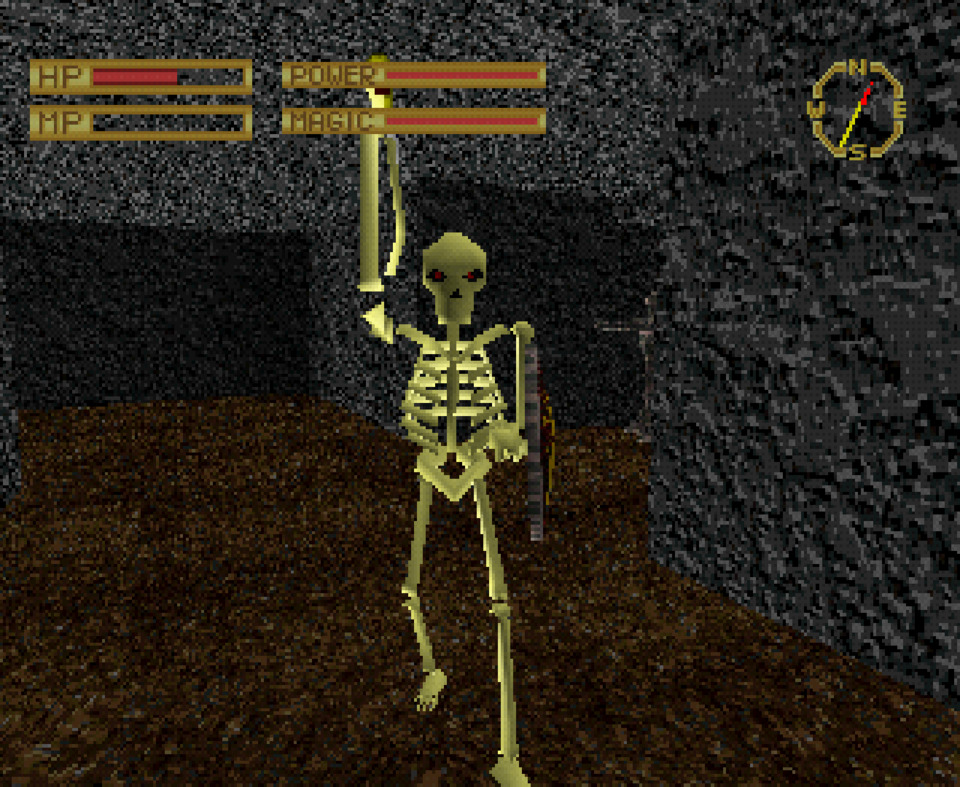
Pressing the attack button swings a polygonal representation of your equipped weapon across the screen. The full animation takes a good two or three seconds. The hitbox for the attack is on that polygonal model, meaning your attack won't hit anything for a good second after you press the button. Also, every enemy in the game attacks between 2x and 4x faster than you, and the depth perception is lousy. To hit an enemy, you need to be within its attack range, and it's going to smack you at least once or twice in the amount of time it takes to hit it once. Remember that you're made out of cardboard at the start of the game. you're unlikely to survive even the first combat encounter, which will likely be against a little walking piranha plant guy. The way to do any and all melee combat in this game is to start your swing outside the enemy's attack range, walk while swinging into range just long enough for your attack to connect, and immediately back out. Doing this results in the enemy hitting you either once or not at all. Considering that this game runs at under 30 fps, has narrow environments, and the potential presence of more than one enemy at a time, this technique takes some time to get right. Nothing about it is intuitive or taught by the game, you either look it up or trial and error your way around for who knows how long. There's also magic, but you're not going to have anywhere near enough MP to rely on it for like the first 2/3rds of the game. If you hadn't realized by now, this is a bad combat system, even by the standards of the time.
Anyway, once the arrow trap is off you can get to the next floor and start aimlessly exploring around. This point is early enough that there aren't any good healing options other than walking back to the fountain on the first floor. One of the few oddly compassionate design choices in this game is that the central hallways on the first two floors are devoid of enemies, so if you can get out of whatever side area you're in, you will be relatively safe until you can heal. There are also healing items that can help extend your stints through the second floor, but that takes us to discussing the inventory system. As you can probably guess from the game's vintage, there are no item descriptions whatsoever for anything. That means you either have to look up what they do or use trial and error. That's fine for the basic items, like the healing herb or antidote herb which are cheap and plentiful. But as you make your way deeper into the game, you'll come across increasingly rare consumables and other items whose purpose isn’t immediately obvious. The best example is the Phantom Rod, which is a single-use item that will reveal false walls and invisible walkways. You won't know what it does until you use it, and even then, it's not immediately apparent, and you also won't know it's a consumable until you use one. There's also like five or six of them in the whole game. They might as well not exist for all the good they do. Then there's the cursed equipment, which you don't find out about until you try it on. Either you've played a cRPG before and know to save before trying on weird high-level gear, or you screw yourself. The entirety of item and equipment management comes across as half-baked. When a modern game pulls this kind of crap, it's intentional and the game is designed around it; when you see it in old games it's because of time or memory constraints and thus usually not adequately accounted for in the design.
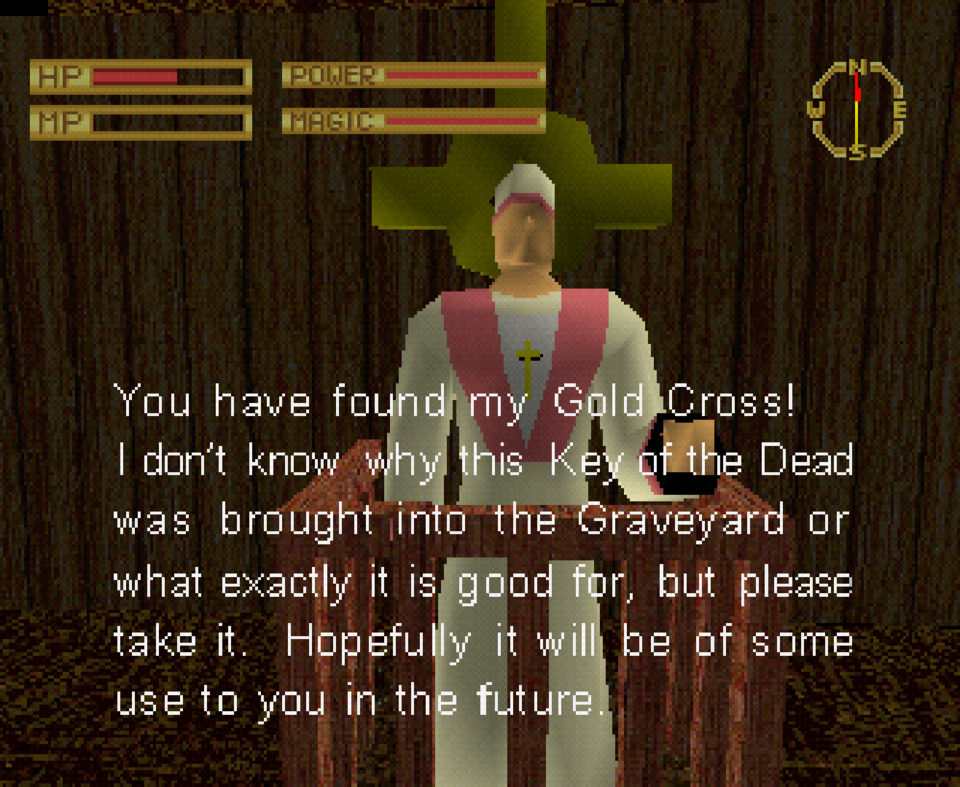
Back to the dungeon crawling, the second floor has a handful more NPCs to deal with. There's a soldier hiding out in a safe room who'll let you know that things went bad on the lower levels and he's the only one who made it out. He can apparently show up in different rooms throughout the game, but I only saw him here. There's a hermit wizard just kinda hanging out in a side cave who'll teach you new magic if you can show him THE TRUTH. There's an item you can find called a Truth Mirror, which explains whatever is in front of you when you use it, that you need to give him. While it is an otherwise necessary item, the magic you learn is the only healing spell in the game, which is vital. Also, you don't know what the magic is before you learn it. Finally, there's a minstrel sitting around at the end of a different side cave who has the item you need to get to the next floor. See, you're cut off from the level exit by a gaping chasm that you can't cross. The minstrel has a harp that will raise a bridge across that chasm when played. While the game indicates that you should find the minstrel, it doesn't point you to the actual utility of the harp. The minstrel wants one of the highest tier healing items in exchange for it, and if you've been poking into every single nook and cranny like I had then you'll have one to hand over. To finish with this level, new and tougher monsters are introduced as you would expect, and traps become more prevalent.
Things become more serious on the third floor. There are enemies who spawn in the central hallway and more of them are capable of throwing ranged attacks around. There's enough of a difficulty bump that it acts as a minor level/equipment check. You're either going to be running back and forth to the healing spring a lot or do what I did and grind infinite spiders on the first floor for like twenty minutes. Even then, your character level is only half the issue, with the other being equipment. That brings us to our next important gameplay feature: hidden rooms. You see, all of the good equipment in the game can only be found in areas beyond false walls. You would know that a wall is false by walking into it and passing right through. There is no other way to find them besides using the aforementioned Phantom Rod. To FromSoft's credit, they wanted the players to be aware of the fact that secret areas exist. The manual directly tells you that false walls exist and on the first two floors there are some areas where the monster AI will patrol back-and-forth through a wall. It would be hard to never realize these things are around, which is good because the critical path requires going through a false wall, though we'll get to that. Besides those, there are like two invisible bridges in the game, one of which is on the critical path. Nothing informs you that these exist, and you're supposed to just know to take a leap of faith. There's a little bit of signposting for the one on the critical path, which is literally two rooms from the final boss, but the other one is only found by throwing yourself into the void. JRPGs had featured invisible walkways before, so maybe Japanese game nerds would have known it as a testable possibility, though the price of experimentation is steep. The game can only be saved at specific save points found in the levels, with only a handful on each floor.

The reason why that description of this game's secrets is important is because the second-best sword in the game is found in a double-secret room on the third floor. If you find it in your first run through the level, it makes the fourth floor so much more reasonable to deal with, if you don't, well…yeah. The thing about that sword, Triple Fang, is that it gradually regens your health and MP, and magic only becomes a viable combat option after equipping it. That's vital as even a low-level attack spell can be important against high level monsters. This is because of how the stamina system works. There are two stamina bars, one for physical attacks and one for magic. Every time you swing your weapon, the physical stamina bar, which is more of a power meter I guess, empties and takes anywhere from one to 3 seconds to refill. You can swing again before it refills, but with a steep damage penalty. The same works for the magic meter, but it tends to refill faster and more consistently. I'll get to a description of the endgame enemies in a bit but suffice to say that the only decent way to deal with them is to stun-lock the jerks by alternating physical and magic attacks. Every time a monster takes damage it has a very short, and usually subtle, stun animation. Because of how long it takes between you being able to land physical attacks, that creates an opening for the monster to use one of their ranged attacks, which you very much do not want the endgame MoBs to use. Firing off magic while the attack meter recharges is the only way to prevent that. But, in order to use magic, you need MP, and the only way to refill MP is either to go to the healing fountain, use the highest tier healing item, or have a weapon with MP regen. Only the two best swords in the game can do that, and you don't get the second one until right before the final boss.
All that is to say you either find the Triple Fang or spend an extra five to ten more hours with the game than you should. Any player who knows anything will make a beeline to that sword first thing after getting to the third floor, after which combat stops being a problem for a while. That's good, because the level design becomes increasingly hostile at this point. Aside from decreasing the number of safe areas and increasing the traps, you start to see more big enemies in confined spaces that you can't run past and more groups of monsters who can gang up on you. Then there's this floor's gimmick. The critical path is blocked by a big stone pillar, and there are four pedestals in side rooms next to it corresponding to the four elements. If you've been thorough you'd have found at least one elemental stone and it shouldn't be hard to figure out what you need to do. If not, then, well…yeah. The thing is that the four stones you need are in four mundane chests scattered across floors two and three with no hint or indication of where to look for them. You could have found one or both of the stones on the previous floor and realized the gimmick, but regardless you're gonna wander around until you find all of them. The only NPC on this floor is the ghost of the king before last who teaches you the fireball spell, which should be the second and most useful attack spell you learn.
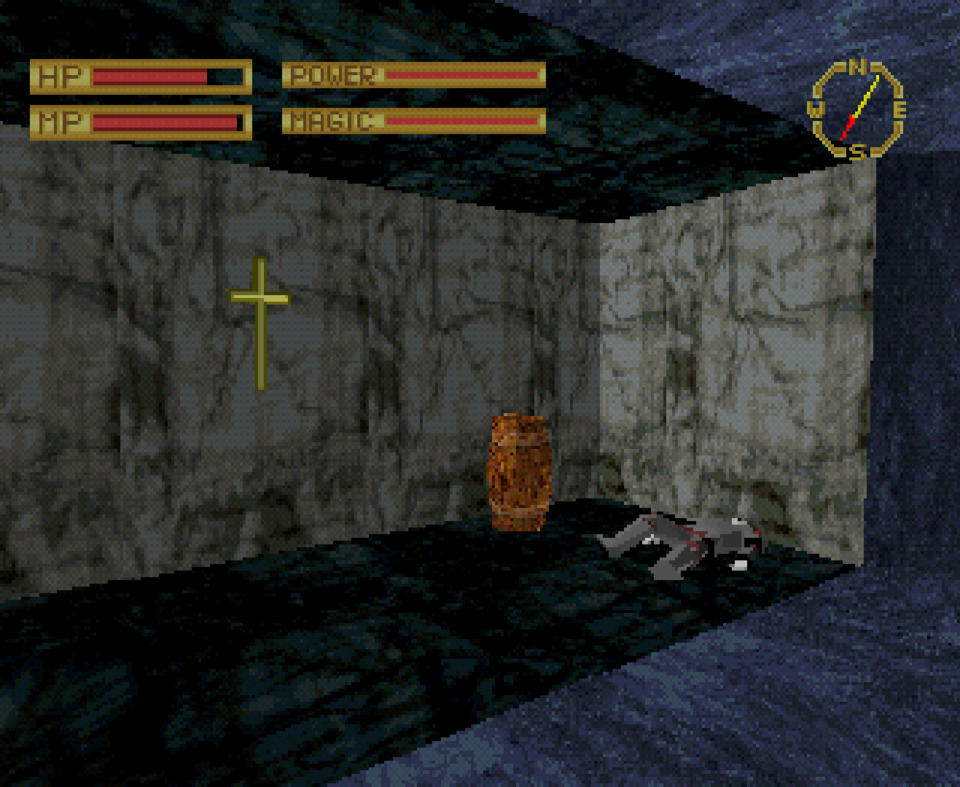
So, you wander the big cave loop of the third floor and maybe retrace the second floor until you find the stones. If you aren't using any resource materials or the Triple Fang, this would be exceptionally tedious. Once the pillar is down, though, you can backtrack to loot an annoying false wall maze or go on to the fourth floor. The thing is, once you cross the point where the stone pillar had been, you're not going to have any shortcuts back to the first floor until after you get to the end of the fourth floor. Previously, the exits on the second floor for the first and third were relatively nearby, making it not that much of a hassle to go back and forth to the shops and fountain. Now, going back from the fourth floor will take a significant amount of time and pose increasing danger. That means the only effective way to continue is to be prepared to do a thunder run from one end of the fourth floor to the other and have enough resources left to deal with a miniboss. Of course, you won't know that in a normal playthrough. Having HP and MP regen makes this immediately feasible, so I only partially stocked up before making the run.
A final note about the third floor. The last section is a linear and very long series of OSHA non-compliant bridges with an opportunity to get a replacement Truth Mirror. Doing so requires using the harp from earlier; this is the third and last spot where it comes up, with the second being a small bridge to access a treasure area on the second floor. The game has two methods of crossing chasms, which are used on a combined five occasions with almost no signposting. Anyway, the fourth floor is mostly linear on the first run through, though the various sections have intentionally spider-like layouts. The hallways are also narrow and filled with the largest enemy type, so there's not much running past anything. Another "fun" aspect is that almost every treasure chest or lootable object is blocked off by a bottomless pit trap. This is literally a combat gauntlet. After the first section, you get an antagonistic hallway filled with swinging spikes that hurt quite a lot. Dodging through them in one direction leads to an incredibly dangerous room containing an improved map and a fake shortcut that teleports you to a dead-end back on the third floor. The other direction takes you to an NPC, a dying soldier laying in an alcove who tells you that your father is already dead and buried. Turns out that reunion isn't happening. Regardless, we've already come this far, so on to the next section of the floor. You need to pass through a couple of rooms with the most annoying enemy in the game, which are jumping undead knights who are a hassle to hit. After that is a section that is the same as the first but going in the opposite direction.
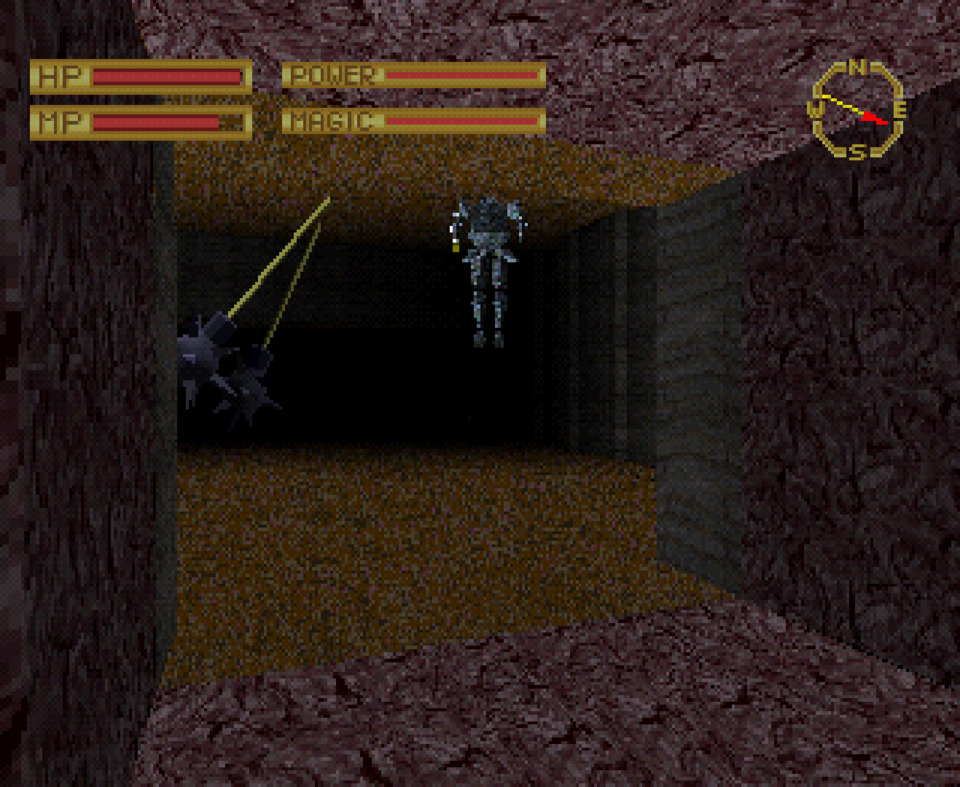
When you finally get to the big central hallway of the floor, you get to encounter your first endgame enemy, big guys who throw boulders at you. Taking boulders to the face is bad for your health, so the distance with them needs to be closed as quickly as the subdued walk speed allows. The reward at the end of this whole mess is a key that unlocks everything in the game. All of the locked doors and chests that would have been bypassed on previous floors are now accessible, as are the shortcuts on the fourth floor. There are multiple side rooms off that hallway, one of which contains the Feather Boots which you need to cross those bottomless pit traps and access your father's grave, which, RIP, I guess, but also you need to grab his sword or else you aren't finishing the game. You are then funneled into the miniboss' room, who is an evil wizard that transforms into a big gnarly skeleton. He isn't difficult when using the Triple Fang. Now you get to the final hall of the floor and a shortcut back to level one. Sadly, all of the nonsense with the fifth, and last, floor is going to require some explanation.
The first thing to note is that a lot of enemies on the fifth floor like to shoot explosive magic with a large area of effect, and those enemies tend to hang out in groups. This means that while you're whacking away at one the others will constantly try to nuke you. This adds an element of constant danger that the previous floor lacked, so good job on the developers, but it's also incredibly obnoxious. Second, this floor features a dragon and ghost elf lady who you absolutely must talk to if you want to actually finish the game, there is of course no clear signposting about this. To understand why they're absolutely necessary requires explaining the last two gameplay features which I have yet to touch on, character progression and sword magic. Being an RPG, you gain experience points from killing enemies and level up at set XP intervals, with your HP and MP increasing with each level-up. Most of the other granular character stats are determined by your equipment, which is very normal. Though, the special stats are strength and magic. These increase independently of your level based on how many physical and magical attacks you perform and are used to determine your character class and whether you can use sword magic. Using the term "character class" is misleading, as this serves merely as a title determined by specific thresholds for those two stats. You get the highest "class" once both stats go above 60. Note that strength and magic max out at 99. You need to be at that highest "class" and have retrieved your dad's sword in order for the ghost elf lady to use the dragon's magic to turn that sword into the game's ultimate weapon, the Moonlight Sword. Doing this is vital, because the final boss can only be defeated by using that weapon's sword magic. The game of course tells you none of this.
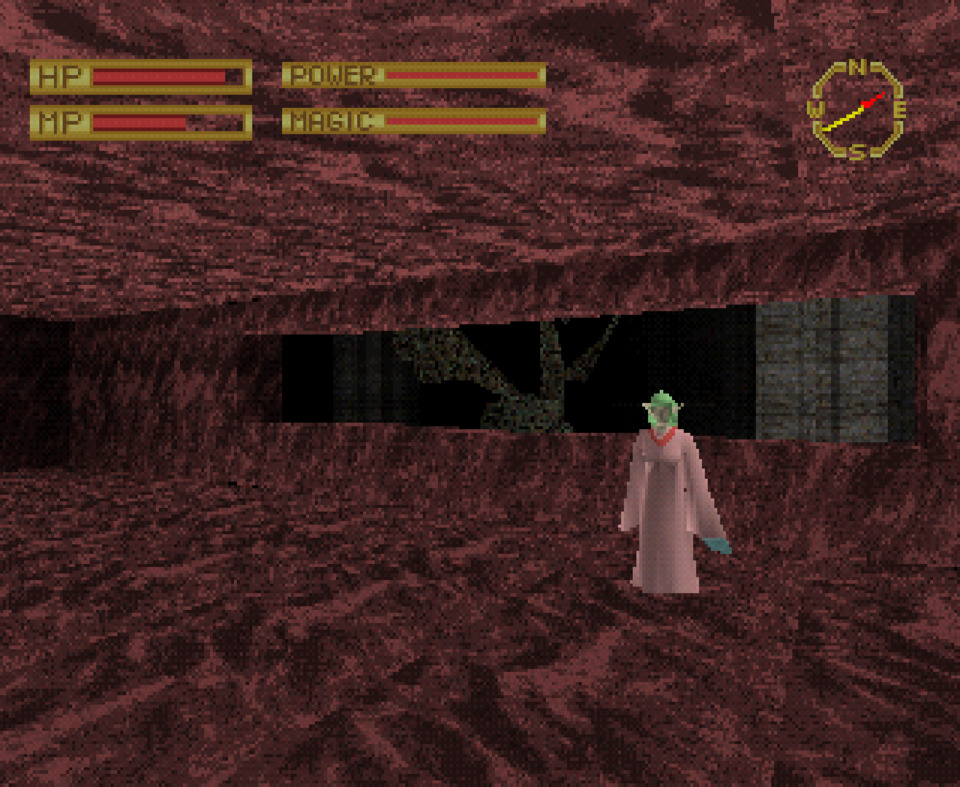
This brings us to sword magic, which is also something the game also doesn't tell you about. There are four magical swords that you can find, with the Triple Fang and Moonlight Sword being two of those. Sword magic is the ability to shoot unique spells using those swords, which is done by pressing the magic button in the middle of a sword swing. This is a bit awkward, but the timing is kinda generous at least. What's less generous are the unwritten requirements for using it. You need to be at the highest "class" in order to use sword magic, and even then, that's only for the two lesser magic swords. To shoot spells from the two best swords you need to have your strength and magic at 80 or above. The information in that last sentence is so obscure that you're unlikely to find it in most online game guides. Yet, the sword magic from the Moonlight Sword is the only thing that can hurt the final boss. This is insane, but also hard to fully appreciate without knowing the deranged nonsense required to even get near the boss.
Getting to the boss room is a convoluted mess. For how dangerous the fifth floor is, it's easily the smallest. Yet, you aren't going to make any progress in it unless you take a very specific and obscure path. Starting in the hallway leading to the dragon room, you need to go through a false wall on one side of the hall. This immediately brings you to a large chasm. The harp doesn't work here, which means you have to use the invisible walkway. If you hadn't found the one other, entirely optional, invisible walkway earlier then you would have no idea that it could even exist. The only hint you have is the presence of torches extending in a double line at the bottom of the chasm, which could potentially mean any number of things. Assuming you do make a leap of faith, going straight will only take you to a dead-end room. You have to stop in the middle of the chasm and turn right to go up some invisible stairs to a teleporter. From there you end up in a room with a bunch of hilariously oversized enemies wandering around. This room has two other teleporters, one of which takes you to a side room that dumps you back into the middle of the fifth floor and the other takes you to the room before the boss. That room contains four of the most powerful enemies in the game, who will kill you even if you have the best equipment. You need to run past those jerks while they throw nukes at you. Getting past that, there's a bridge over another chasm with fireball traps constantly shooting across it. Fireballs shouldn't hurt much at this point, but their presence encourages you to accidentally throw yourself into the void. After that, you finally reach the boss room.
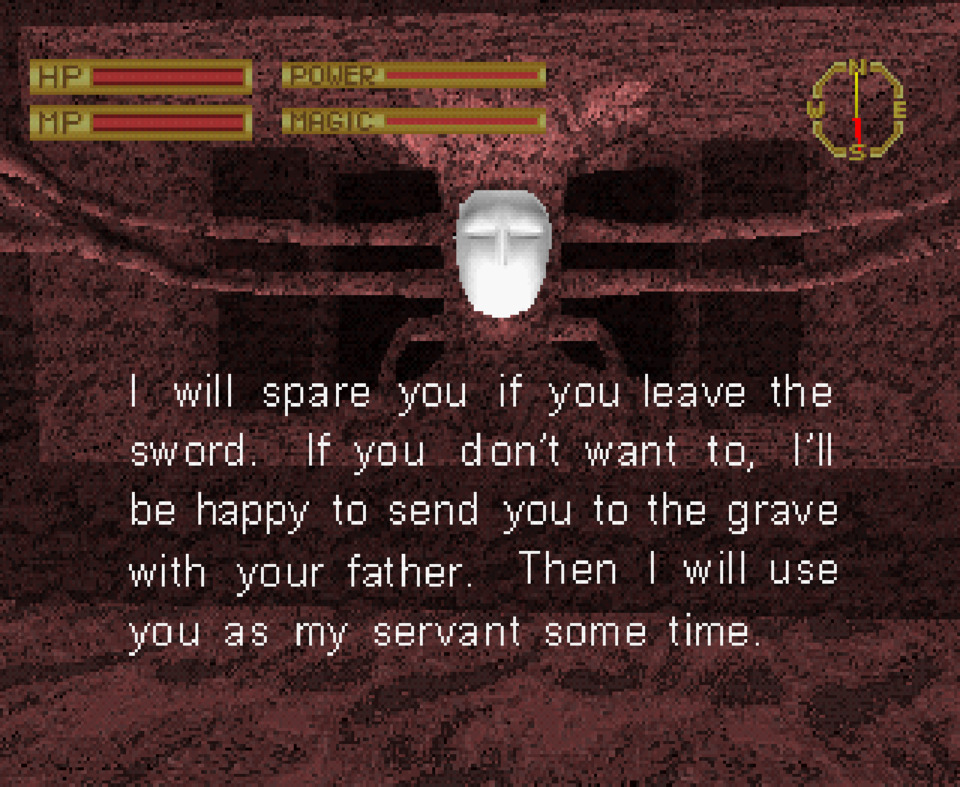
This place is a small area with a chasm between you and the boss itself, which is an evil tree. There are also magic shooting traps saturating the half of the room closest to the boss, there's a single pillar in the middle of the back half of the room, with only a narrow space between it and the chasm you would have just crossed. The boss itself shoots nukes, fireballs, and monsters at you when you aren't standing in the middle of the magic traps and will whack at you when you are. Existing anywhere in the room that isn't behind the pillar involves taking constant and significant damage. You can't attack the boss directly with your weapon, which encourages you to use magic, but none of the normal magic spells do any damage to the boss. You only figure this out after firing magic at it for too long. The Moonlight Sword's magic is the only way to damage the thing, which you have no way of knowing. I went through almost all of my healing items trying to throw magic at it for at least ten minutes. The thing is, I knew about the 60 stat requirement for sword magic, but I didn't know about the 80 requirement. Because of this, I thought the sword magic was just busted in my copy of the game. Turns out I had my magic stat at 81 and my strength at 79, which put me right below the threshold. I didn't realize this until people watching my stream found an old forum post explaining the 80 stat requirement. I went back to the giant enemy room to grind for like three minutes to get myself above the threshold, made my way back to the boss, and killed it in less than a minute. This is unforgiveable boss design. It would be just to the left of impossible to beat this game without access to online resources or a like-minded peer group. Yet, before I get into the total quality of this experience, we need to make one last digression.
Fun Fun Level Design Corner
It'll be useful to stop every now and then to examine the evolution of FromSoft's level design philosophy. As this is their first game, there isn't a ton of personality beyond standard dungeon design concepts. Though, that makes this the ideal baseline from which we can judge later titles. Also, there's only five levels in this thing and looking at each of them won't take that long.
Before getting into it, the specific maps we'll be referencing were apparently published back in 2004 by someone named Martin Ramirez, and they were drawn by his then 9-year-old daughter, Sam, as they played through an old, imported copy of the game and using the opportunity to practice Japanese reading comprehension. It's a surprisingly heartwarming little story, and since these are still the best maps available most people who have played this thing in the last 20 years owe them a debt of gratitude. Wherever Martin or Sam are, I salute them.
Floor 1:
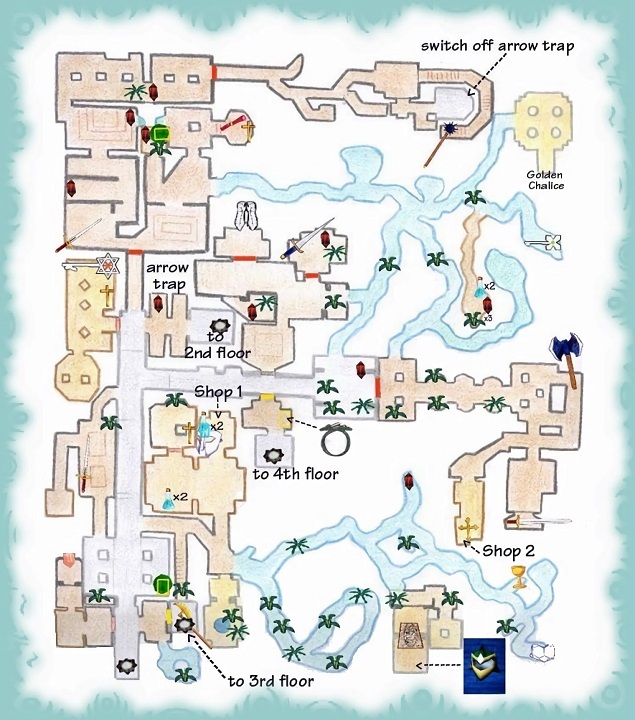
The first floor is divided into roughly six zones. First, there's the starting area in the bottom left corner, which is mostly devoid of enemies and also contains most of the NPCs in the game. The main shop and healing fountain are located directly across a hall from each other, and the church area is in its own room off on the left. The first place a new player will likely encounter combat is either the cave system in the bottom right or the two room areas in the center of the map. Two of the zones are initially locked off behind Star Key doors and need to be accessed the long way through the upper right cave system. We can see the spot where you get the chalice at the far end of the bottom caves and its receptacle at the end of the top cave. Also, the fountain is on the opposite part of the map from the chalice receptacle, and there's little-to-no in-game indication that any of it is related to each other. We can also see that second shop at the other extreme end of the upper caves, and that's where you need to fork over way too much cash to buy the cross for the priest in the far-left room. Finally, the switch to turn off the trap blocking the centrally located level exit is all the way at the end of the upper zone, which is the first major graveyard area and also the location of the infinite spider spawner.
Putting the item and delivery locations so far apart is supposed to encourage the player to wander around the level multiple times in confusion. The idea might be that this wandering would give the player more opportunity to notice the false walls, grab treasure in all the various nooks and crannies, and accrue enough levels to survive the second floor. You're probably supposed to figure out what you're doing by the time you exit this floor, even if it takes several hours. I have to imagine that most people wouldn't get past the awkward combat, maddening obscurity, or slow pace of this floor, unless they had to for weird reasons like me. Regardless, this is the least hostile layout in the game, with the fewest traps and false walls. That gets ramped up on the next floor.
Floor 2:
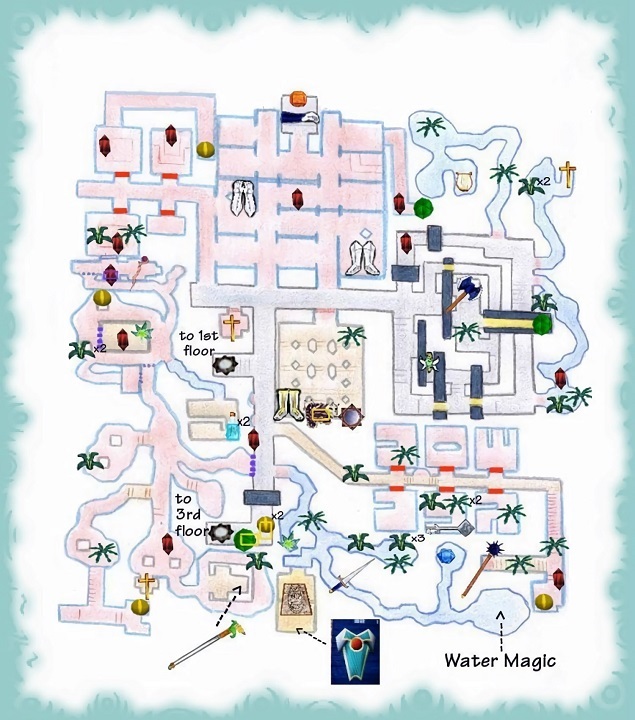
As with the previous floor, the central T-shaped hallway is devoid of violence, giving easy access to the level exits and save room. There's much more of a hub-and-spoke layout here than you typically see in FromSoft games. We have another six zones branching off from the central hall, with all but two being disconnected from each other, and even then, that one connection between the upper and lefthand sections is barely worth consideration for how involved it is to unlock. This floor also features the first magic upgrade and three out of the five invisible/harp bridges in the game. You're supposed to have figured out all the quirks and hostile inclinations in the game design by the time you get through this floor.
At first blush, it looks like all you need to do is go through the bridge maze and caves in the upper right to get the harp and then across the central chasm to the level exit. Each of the other zones are important to either get the two elemental stones (at the far end of the upper middle graveyard maze and in a random offshoot of the lower right cave system) and two optional but actually necessary power-ups. First, the wizard at the far end of the lower right caves is the one we discussed earlier who wants THE TRUTH. Second, you need to get a key from the right-center series of rooms to access the large lefthand area, the bottom of which features an item that lets you teleport to the current floor entrance, making backtracking so much more feasible. Getting everything that you either need or need will require full and thorough exploration. This was likely an assumed skill for players of those early cRPGs that this game spiritually references. Finally, note the reduction in save points (crosses) to three from four on the previous level. Part of the difficulty curve here is going to be the throttling of save locations.
Floor 3:
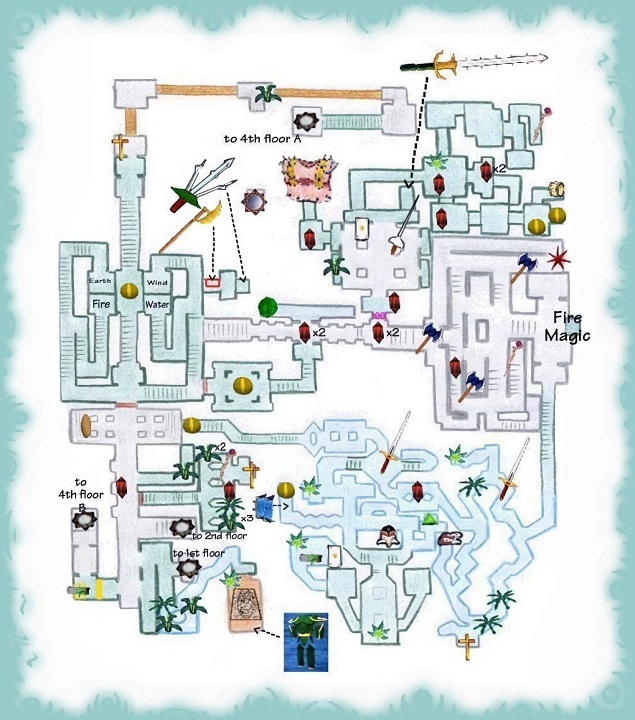
This is the first floor with no significant safe areas. There are also only five zones here compared to the six in the previous floors. Those zones are the entrance area in the bottom left, the shrine gate area in the upper left, the main loop of the level comprising the middle and lower right zones, and a false wall maze in the upper right that is unlocked after slotting those elemental stones. That area is optional because the main reason to go there is that wavy sword you see in the picture; this sword is superseded by the super-duper-secret Triple Fang that you can see hidden beyond three consecutive false walls sticking out of a random hallway in the shrine. If you don't see it, the Triple Fang is the dumb looking sword that literally has three blades sticking out of the hilt. The inclusion and placement of that sword is the kind of thing you usually see done by novice dungeon designers, since having it breaks the back third of the game and it's almost impossible to find naturally.
Going back to that main loop, the middle-right zone is where you learn the second piece of offensive magic, which has no other prerequisites than wandering into the room. Also, the final two elemental stones are found in this loop, making thorough exploration of these areas a requirement. You can see another Truth Mirror hanging out in the middle of nothing in the upper bridge area. This is the final place in the game where you can use the harp, so I guess that item's utility doesn't last long. Make note again of the scarcity and distance between save points, and the tedious distance between the level entrance in the lower left and the exit in the upper center. The game really wants you to take the next floor in one go.
Floor 4:
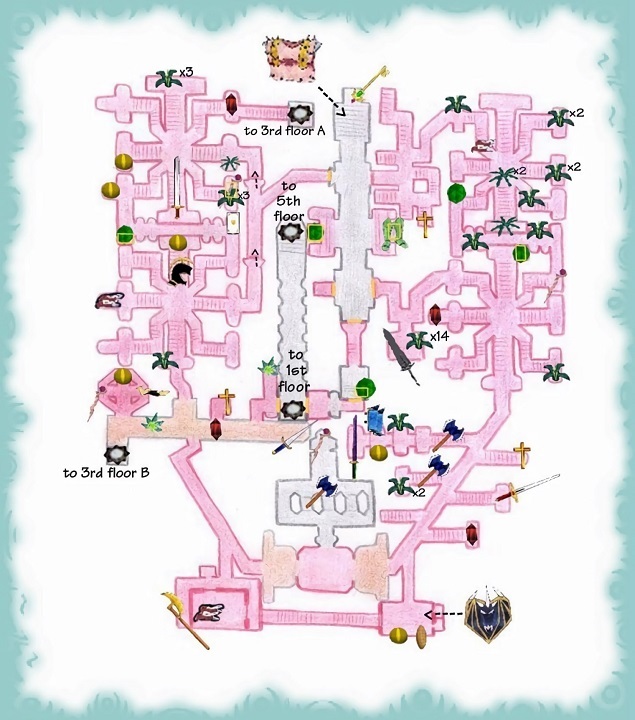
That brings us to this mess. There are really only four zones on this level, and they form a straightforward progression going from the upper-left counterclockwise to the upper-right and then down the central hallway, which is at the end of the level instead of the beginning. This is an incredibly linear level with copy-pasted rooms designed to disorient and turn around the player. Notice in the upper-left zone that south-to-north hallway with dropdowns that act as an early noob reset for anyone trying to explore around. Remember that the previous floors train the player to explore around. The bottom zone is filled with traps and high-level monsters, making it the most tedious slog in the entire game. Your reward for getting through that is to do the upper right zone, which is identical to the upper left. Keep in mind that all the treasures you see in those two upper zones are blocked off with instant death traps, which can only be overcome by the boots you see on the right side of the central hallway. Also, notice that the three save rooms are positioned at the end of the three linear zones, creating an intended run-based progression through each zone. All of this would be an enormous hassle and difficulty spike without the Triple Fang.
At the end of this Maze of Death, you get to the central hallway, which is filled with endgame enemies. The north end has the extremely necessary final key, the side rooms have those boots and your dad's sword, and the south has the unassuming miniboss room. The floor ends in that left-of-center hallway connecting a shortcut to the first floor with the level exit. That last bit is surprisingly humane, giving you a direct path from the shops and fountain to the endgame. That's why this level seems so schizophrenic. The initial trip through the floor is the most mean-spirited and unsubtle section of the game, but you get a nice little quality of life shortcut at the end. It's all painfully amateurish. Even though this is the most hateful layout, that doesn't mean it's a shittiest. That takes us to the endgame.
Floor 5:
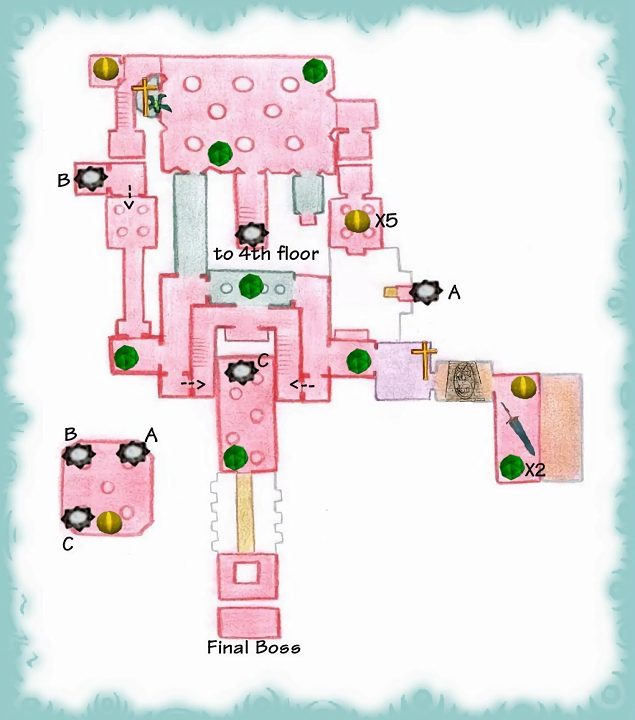
The last floor is significantly smaller than the previous ones and can be divided into three zones. The first zone in the upper part of the floor is the last exploration area of the game, but it's also filled with miniboss enemies that are eager to kill you, and most of the items aren't really worth the trouble. There's also a save point in an alcove, but since it's largely unprotected from the combat area it's more of a good place to get caught in a death loop. The next zone directly below that is a series of hallways filled with those previously mentioned enemies and nuke spells. You can't really catch a breath until you make it to the far-right side with the only viable save point and the dragon room. Receiving the Moonlight Sword from the dragon is, as stated earlier, necessary to beat the game. At this point there is a subtle implication that you should go back through the previous floors unlocking all of the previously inaccessible chests and doors to get the endgame equipment. While you could go straight from the dragon to the boss room, you can't beat that boss without 80 Strength and Magic, so you're likely gonna have to grind regardless. Not that you would know any of this, or likely even make it this far, playing it casually.
This at last brings us to the inexplicable design of the section leading to the boss. From that final save point, you're supposed to go to the previous room, walk north through a false wall, with no indication that it's there, and cross an invisible bridge over the chasm you find on the other side. To reiterate, anyone doing an unresearched playthrough wouldn't have been given any indication that invisible walkways are even a thing, unless you had stumbled on that optional bridge earlier. Since the harp doesn't do anything here the only way to figure it out naturally would be to yeet yourself into the void or burn a phantom rod, if you even have any left. For as harebrained as this is, it gets worse. You see that there are two destinations across the chasm, in front and on the right. You need to use the righthand exit, which involves lining yourself up in the middle of the invisible walkway and going up some invisible stairs. This is the second leap of faith in a row, because why not. That teleporter takes you to the room with hilariously oversized enemies, which is the last grinding spot of the game. There are two exit teleporters in corners that look identical, and with the limited draw distance and the need to dodge around those enormous idiots, it's very easy to get turned around and go through the wrong exit. Fortunately, you can immediately reenter a teleporter after going through it, but you're likely to drop down the noob reset on the left side of the floor at least once.
Going through the correct teleporter takes you to a hall with four of the highest-level enemies in the game who like to throw around nuke spells like it's going out of style. This gauntlet of everything constantly exploding is harrowing for the player and the game's framerate, with the real kicker being that you have to run through it every time you retry the boss. Then there's the final bridge with the fireballs and the tiny boss arena at the very bottom. Considering the previously described boss design, this entire final sequence is deranged in a way that I can't parse. The sensibilities here seem to be on the same level as masocore Mario Maker levels. More than anything else, this final floor lays bare the rushed and amateurish nature of this game. If someone pulled this kind of design while DMing a D&D dungeon, they probably wouldn't be encouraged to DM again. That brings us to the final question.
Reference Material
This game would be unplayable without outside resources, and for full transparency here are the guides and other information I used to play this game:
----------------------------------------------------------------------------------------------------
What can we make of this?
After that exhaustive description, and in context of how the Japanese game market reacted to it, I have no idea what to make of this thing. It makes perfect sense why Sony and game reviewers would have seen this and been unenthused. It's janky, runs badly, has miserable combat, and is too obscure for its own good. Most of the technical and gameplay problems can likely be attributed to the purely polygonal nature of the game. No one had made one of these with polygonal monsters and NPCs, likely because of how resource intensive it is. That gimmick would have hogged development time, disc space, and compute cycles to an extent that would require sacrificing additional depth in game mechanics, storytelling, and level sophistication. This is clearly a work by enthusiastic amateurs who loved bad old 80's RPGs, and smart money would have bet on it being a failure. In this day and age, a game like this would be self-published on Steam and die in mediocre obscurity.
So, why did it resonate with a profitable niche of Japanese gamers? If we're to accept the 200,000 sales number of this thing by the release of King's Field II, then the back-of-napkin estimate for gross revenue would be somewhere around $10 million, give or take. Fromsoft would have seen some percentage of this after everyone else took their cuts, but they still would have come into possession of several hundred million yen over those six months. Being a small company, that might have been more revenue than Zin would have seen over any six months in the company's eight-year history. From their point of view, investing further into video games would have been the obvious move, and hoo-boy did they do exactly that. But what were those 200,000 customers thinking? There's evidence of a disproportionate amount of talk going on in internet chat rooms, and that word of mouth is credited for the game's success. That brings us back to what people would have seen in this wretched little dungeon crawler.
I've put too much time and effort into trying to come up with an answer. At this moment, I think it has to do with the psychological strings tugged by abstruse games. Hidden content was the normal design philosophy in the early NES days. You know how Super Mario Bros had secret warp rooms and inconspicuous power-up blocks? How about the hidden cave/dungeon entrances in The Legend of Zelda? This goes all the way back to the mystery conditions needed to collect items and power-ups in Tower of Druaga. Game companies worked under the assumption that their target audience would obsessively replay games if they thought there were hidden goodies to find. That audience was overwhelmingly made up of boys in late pre-pubescence and early adolescence. Not being a child psychologist, I can't dig into that any further. That's not saying these games couldn't appeal to other demographics if they were well-made or popular enough to enter the mainstream. However, that psychological mechanism works, and it wouldn't have gone away just because game design had started drifting towards appeal to wider audiences.
King's Field is, if anything, a love letter to bad 80's game design. I think the kinds of boys and young men that those design standards were meant to appeal to discovered and latched onto this game. Mind you, that's only a couple hundred thousand people, which would have been a respectably sized fanbase in 1985 but not as much in 1995. As a spoiler for the next entry in this series, the King's Field series didn't exactly increase in popularity from game to game, so maybe the actual fanbase was closer to 100,000 people with the rest being suckers like me who fell for word-of-mouth.
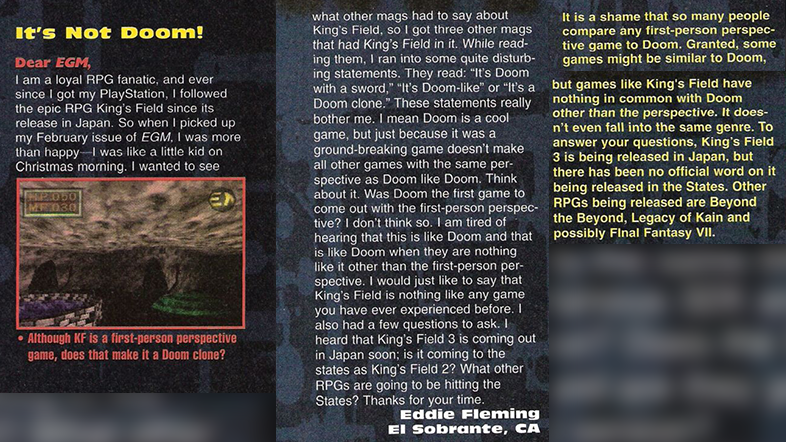
Another factor to consider would have been the paucity of dungeon crawlers available on consoles. The only other game even close to this which would have been contemporaneously available on next gen consoles is Crime Crackers, which barely counts. The next dungeon crawler, Space Griffon VF-9, came out a month later but was also a very different thing. Really, you don't see another one of these until Virtual Hydlide and King's Field II in mid-1995. This is an extremely cursed line-up, so I can see how anyone wanting a dungeon crawler would have landed on this game in the early months of the generation. I know I'm reusing my theory for the success of the original Hydlide, but timing makes and breaks all kinds of media products. Speaking of Hydlide, and I apologize for not including a content warning, even though this game is less janky, mechanically deeper, and overall plays better than Virtual Hydlide, I think I would prefer that tire fire of a game over this. With that game, there's about 30 minutes of misery and then two or three hours of messing around, whereas here there are multiple hours of misery at the beginning and end of a 8-9 hour experience. Mind you that both cases involve referencing guides. The appeal of both also makes use of the same kind of mind virus, you become From-pilled in a similar mechanism as becoming Hydlide-pilled. It's the same itch in the back of my brain. Once you figure out what's going on in a bad game, and know how to solve for those problems, you can have a good time given a tedious enough personality.
I'm not going to touch on the hot buzzwords surrounding modern FromSoft games, such as difficulty, fairness, or 'git gud'. There will be plenty of opportunities to wallow in the intellectual muck of those topics, and I plan on doing so repeatedly as we look at the FromSoft catalog. For now, there are more games to suffer through and only so many hours in the day. The next entry in this series will either be on King's Field II on its own or with the addition King's Field III, depending on how much I have to say. I'm not going to make any promises on a set schedule for these things, so it'll happen when it happens. No matter how long it takes, by the time I catch up with the present day, I will be able to tell the world in minute detail why, in fact, all FromSoft games are bad.
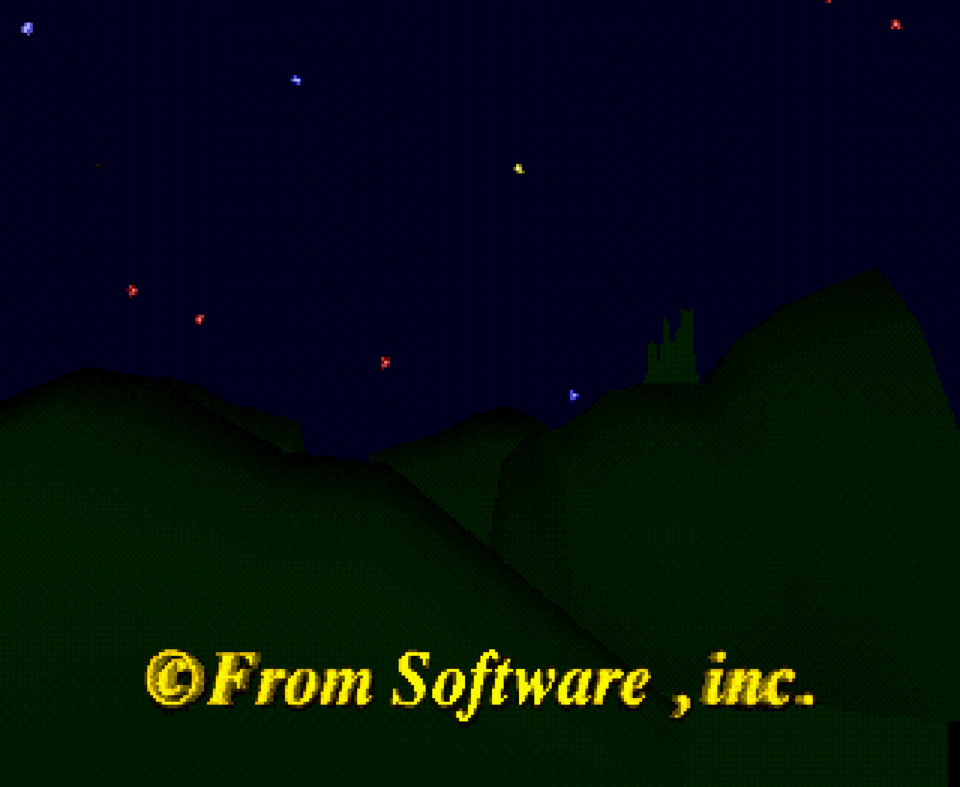
Sources
Background info was cobbled together from the following sources:
- https://www.reddit.com/r/KingsField/comments/10eveid/i_wrote_some_behindthescenes_information_about/
- Too many Wikipedia articles
- All else was revealed to me in a dream
----------------------------------------------------------------------------------------------------
I'm streaming myself as I play through all these FromSoft games and other antiquated garbage, which can be found on my Twitch channel. Stream archives can be found on my YouTube channel. The first part of my King's Field playthrough (overlaid with inane chatter) can be watched below.
Log in to comment